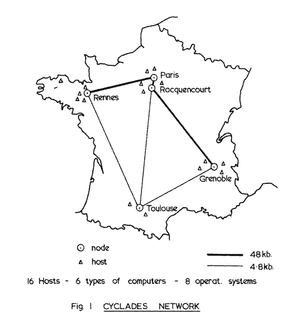Internet: Difference between revisions
No edit summary |
No edit summary |
||
| Line 16: | Line 16: | ||
Nodes were delegated to different campuses located in Western and Northeastern United States. This process began in 1969 when [https://en.wikipedia.org/wiki/BBN_Technologies BBN], a research and development firm based in Cambridge, Massachusetts, delivered the first Interface Message Processor, or [https://en.wikipedia.org/wiki/Interface_Message_Processor IMP]<ref name="Living Internet">Michael Hauben. [http://www.livinginternet.com/i/ii_arpanet.htm ARPANET]. Retrieved 26 Mar 2015.</ref> to Kleinrock at UCLA. Here, graduate students [[Vinton Cerf]], [[Steve Crocker]], [[Bill Naylor]], [[Jon Postel]] and [[Mike Wingfield]] connected their node via hardware with the IMP. The work was a success and messages between the two machines passed without interference thereafter. | Nodes were delegated to different campuses located in Western and Northeastern United States. This process began in 1969 when [https://en.wikipedia.org/wiki/BBN_Technologies BBN], a research and development firm based in Cambridge, Massachusetts, delivered the first Interface Message Processor, or [https://en.wikipedia.org/wiki/Interface_Message_Processor IMP]<ref name="Living Internet">Michael Hauben. [http://www.livinginternet.com/i/ii_arpanet.htm ARPANET]. Retrieved 26 Mar 2015.</ref> to Kleinrock at UCLA. Here, graduate students [[Vinton Cerf]], [[Steve Crocker]], [[Bill Naylor]], [[Jon Postel]] and [[Mike Wingfield]] connected their node via hardware with the IMP. The work was a success and messages between the two machines passed without interference thereafter. | ||
Researchers at Doug Engelbert's Stanford Research Institute (SRI) were next to receive an IMP. Upon receipt, members at UCLA and Stanford conducted the first network inter-nodal communication. Using a low-speed dial-up line, the researchers developed a connection, testing the packet transmission. The experiment was a minor success, scientists in Stanford received the 'L' and 'O' of 'LOGIN', and the transmission consequently crashed ARPA's fragile network. Regardless of its initial gaps, the "packet-switching" communication test incrementally inched researchers toward a more complete formation of [[ARPANET]]. <ref name="Hx of Internet"/> | Researchers at Doug Engelbert's Stanford Research Institute (SRI) were next to receive an IMP. Upon receipt, members at UCLA and Stanford conducted the first network inter-nodal communication. Using a low-speed dial-up line, the researchers developed a connection, testing the packet transmission. The experiment was a minor success, scientists in Stanford received the 'L' and 'O' of 'LOGIN', and the transmission consequently crashed [[ARPA]]'s fragile network. Regardless of its initial gaps, the "packet-switching" communication test incrementally inched researchers toward a more complete formation of [[ARPANET]]. <ref name="Hx of Internet"/> | ||
''' ARPANET Nodes''' | ''' ARPANET Nodes''' | ||
Revision as of 17:57, 8 December 2015
The term Internet is used to describe the interconnected servers, computers, and networks that work through a standard protocol and provide the structure for information to be accessed on "The Web." In popular culture, the terms "Internet" and "Web" are sometimes used interchangeably to refer to the publicly-accessible websites and servers that can be reached using a Web browser. The Internet gives its users global broadcasting abilities, access to and the ability to add to world knowledge, as well as make it possible for collaboration regardless of location. [1]
History
United States
To counteract the perceived threat of Russian space exploration during the Cold War, the United States boosted investment in research and computer science. Fearing the potential destruction of the national telephone line network, the United States turned to J.C.R. Licklider, a psychologist and computer scientist at MIT and DARPA to develop a robust, defensive alternative.[2]
Beginning in 1962, Licklider developed his "Galactic Network" concept, referred to as an expansive network of computers that would offer its users access to data and programs from a series of sites. After becoming the first head of DARPA's computer research program in October 1962, Licklider successfully convinced his colleagues of the vision's merit in a organization-wide memo, referring to the idea as a "the main and essential medium of informational interaction for governments, institutions, corporations, and individuals.", and "open to all." [3]
Contemporaneously, Leonard Kleinrock, a computer scientist at UCLA, pursued the feasibility of packet switching, a method of information delivery that sends data in small "packets", or portions through different routes as a part of his doctoral research. This concept was thought to be a central component of the mechanics of the Internet, and would later lend a hand in the development of inter-network communication.
ARPANET
The Advanced Research Projects Agency Network (ARPANET) was a branch of the United State's military and earliest iteration of the Internet. It used a packet-switching method to transmit information between various 'nodes' across the country via an IMP or Interface Message Processor. It was also the first network to use TCP/IP, developed by Vint Cerf and Robert Kahn.
Nodes were delegated to different campuses located in Western and Northeastern United States. This process began in 1969 when BBN, a research and development firm based in Cambridge, Massachusetts, delivered the first Interface Message Processor, or IMP[4] to Kleinrock at UCLA. Here, graduate students Vinton Cerf, Steve Crocker, Bill Naylor, Jon Postel and Mike Wingfield connected their node via hardware with the IMP. The work was a success and messages between the two machines passed without interference thereafter.
Researchers at Doug Engelbert's Stanford Research Institute (SRI) were next to receive an IMP. Upon receipt, members at UCLA and Stanford conducted the first network inter-nodal communication. Using a low-speed dial-up line, the researchers developed a connection, testing the packet transmission. The experiment was a minor success, scientists in Stanford received the 'L' and 'O' of 'LOGIN', and the transmission consequently crashed ARPA's fragile network. Regardless of its initial gaps, the "packet-switching" communication test incrementally inched researchers toward a more complete formation of ARPANET. [1]
ARPANET Nodes
- Network Measurement Center at UCLA, led by Kleinrock
- Stanford Research Institute (SRI), led by Doug Engelbert
- Network Information Center, led by Elizabeth J. Feinler
- UC Santa Barbara
- University of Utah
ARPANET Email
The first public demonstration of ARPANET's capabilities was at the International Computer Communication Conference in October, 1972. This exhibition is thought to have inspired confidence in developing network technologies and support for further development. [5] In May of that year, Ray Tomlinson completed programming an application that would allow inter-network messaging, from user to user. The program expanded, giving users the ability to not only read messages, but file, forward and respond directly to messages. [2]
Beyond ARPANET, 1973
Having secured ARPANET's closed network, Robert Kahn and Vinton Cerf collaborated on connecting multiple networks. This project later transitioned into Transmission Control Protocol/Internet Protocol (TCP/IP), and would allow multiple networks to interact and stand alone with security separate from their interconnected family. This also allowed a decentralized approach to managing networks.
In the same year ARPANET made its first international connections to the University College of London and the Royal Radar Establishment of Norway. [5]
ICANN
Great Britain
Donald Davies
In addition to the packet switch methods being developed in the United States, various computer scientists were working on similar programs in the UK. Donald Davies, a computer scientist and originator of the term "packet", helped to create a packet switch network for the National Physical Library (NPL). [6]
Davies originally conceived of a better way for computers to communicate with one another in 1965, and after a short break he returned to the NPL to turn the idea into reality. Davies succeeded in creating two short-lived networks Mark I and Mark II, both of which did not gain traction. After much research, Davies turned outward for support only to find a British populace unconvinced that a wide area network required funding.[6]
France
CYCLADES and Louis Pouzin 1970s
Believing their country to be technologically underdeveloped, French politicians made sweeping measures to grow the country's computing capacities, investing in government and educational institutions.[7]
Under government sponsorship, Louis Pouzin and others visited U.S. universities to learn more about ARPANET and packet switching. Pouzin thought ARPANET to be too complex and burdensome and decided to refine the packet process by individually labeling and sending each packet, not necessarily in sequential order and not necessarily with a connection between sender and receiver. [8] The receiving computer would piece together the individual packets, or datagram. While this network was certainly seen as the European competitor to ARPANET, its creation informed many U.S. Internet innovators including Vint Cerf and Bob Kahn.[7]

In the late 1970s the French government withdrew its funding and disbanded Pouzin's team. It decided to back other networks that relied on circuit sharing, rather than the newer, riskier packet sharing. Pouzin's work went beyond CYCLADES, informing a class of American academics who went on to develop some of the essential structures of the internet.[7]
References
- ↑ 1.0 1.1 Internet Society. A Brief History of the Internet Brief History of the Internet. Retrieved 19 Mar 2015.
- ↑ 2.0 2.1 History.com Staff. The Invention of the Internet. Retrieved 20 Mar 2015
- ↑ Joel Garreau. Radical Evolution. Retrieved 27 Mar 2015.
- ↑ Michael Hauben. ARPANET. Retrieved 26 Mar 2015.
- ↑ 5.0 5.1 The New Media Institute. History of the Internet. Retrieved 20 Mar 2015.
- ↑ 6.0 6.1 Donald Davies. Internet Hall of Fame. Retrieved 24 Mar 2015.
- ↑ 7.0 7.1 7.2 The Economist. The Internet's Fifth Man. Retrieved Mar 25 2015.
- ↑ Roger Moore. Presentation and Major Design Aspects of the CYCLADES. Retrieved 07 Apr 2015

